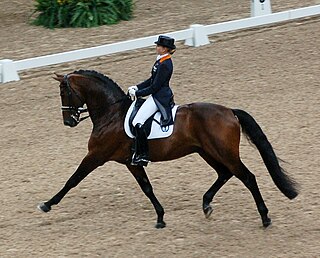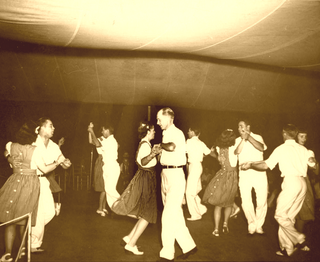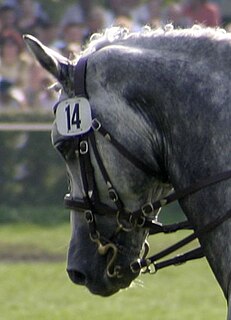
Dressage is a form of horse riding performed in exhibition and competition, as well as an art sometimes pursued solely for the sake of mastery. As an equestrian sport defined by the International Equestrian Federation, dressage is described as "the highest expression of horse training" where "horse and rider are expected to perform from memory a series of predetermined movements."

A square dance is a dance for four couples -eight dancers in total- arranged in a square, with one couple on each side, facing the middle of the square. Square dances contain elements from numerous traditional dances and were first documented in 16th-century England, but they were also quite common in France and throughout Europe. Early square dances, particularly English country dances and French quadrilles, traveled to North America with the European settlers and developed significantly there.

Equestrianism, commonly known as horse riding or horseback riding, includes the disciplines of riding, driving, and vaulting. This broad description includes the use of horses for practical working purposes, transportation, recreational activities, artistic or cultural exercises, and competitive sport.

A horse show is a judged exhibition of horses and ponies. Many different horse breeds and equestrian disciplines hold competitions worldwide, from local to the international levels. Most horse shows run from one to three days, sometimes longer for major, all-breed events or national and international championships in a given discipline or breed. Most shows consist of a series of different performances, called classes, wherein a group of horses with similar training or characteristics compete against one another for awards and, often, prize money.

The Lipizzan or Lipizzaner, is a horse breed named for the Lipizza Stud of the Habsburg monarchy. Generally gray in color, the Lipizzan is a breed of Baroque type that is powerful, matures slowly, and noted for longevity. The breed is closely associated with the Spanish Riding School of Vienna, Austria, where the horses demonstrate the haute école or "high school" movements of classical dressage, including the highly controlled, stylized jumps and other movements known as the "airs above the ground." The horses at the Spanish Riding School are primarily selected from those bred at the Piber Federal Stud, near Graz, Austria, and trained using traditional methods that date back hundreds of years, based on the principles of classical dressage.

Classical dressage evolved from cavalry movements and training for the battlefield, and has since developed into the competitive dressage seen today. Classical riding is the art of riding in harmony with, rather than against, the horse.

The Spanish Riding School is an Austrian institution dedicated to the preservation of classical dressage and the training of Lipizzaner horses, based in Vienna, Austria, whose performances in the Hofburg are also a tourist attraction. The leading horses and riders of the school also periodically tour and perform worldwide. It is one of the "Big Four", the most prestigious classical riding academies in the world, alongside the Cadre Noir, the Portuguese School of Equestrian Art, and the Royal Andalusian School.
Freestyle to Music, sometimes known as Musical Kur or simply kur is a form of dressage competition where the horses paces are set to music to create a competitive "dance". Movements and figures are choreographed to meet the technical requirements of the particular level with carefully chosen music that highlights the horse/rider combination. Musical Freestyles are entertaining and offer great audience appeal. International level competition comprises Prix St. Georges for Young Riders, Intermediate I and Grand Prix through the Fédération Équestre Internationale (FEI).

A double bridle, also called a full bridle or Weymouth bridle, is a bridle that has two bits and four reins. One bit is the bradoon, is a modified snaffle bit that is smaller in diameter and has smaller bit rings than a traditional snaffle, and it is adjusted so that it sits above and behind the other bit, a curb bit. Another term for this combination of curb and snaffle bit is a "bit and bradoon", where the word "bit" in this particular context refers to the curb.

A pas de deux is an equestrian performance using two horses. The horses perform dressage movements, usually mirroring each other, and almost always accompanied by music. Pas de deux are often performed in exhibitions at special events, and are also used by professional acts, particularly the Spanish Riding School.

Equestrianism made its Summer Olympics debut at the 1900 Summer Olympics in Paris, France. It did not return until 1912, but has been featured at every Summer Olympic Games since. The current Olympic equestrian disciplines are Dressage, Eventing, and Jumping. In each discipline, both individual and team medals are awarded. Women and men compete together on equal terms.

The leg-yield is a lateral movement in which a horse travels both forward and sideways at the same time. The horse is fairly straight through his body in the leg-yield, although he may have a slight bend opposite to the direction of travel. It is one of the "three initial movements leading up to true lateral work", the others being the turn on the forehand and the shoulder-fore.
Lateral movements or lateral flexions within equestrianism, have a specific meaning, used to refer to movements made by a horse where the animal is moving in a direction other than straight forward. They are used both in training and in competition, vary in difficulty, and are used in a progressive manner, according to the training and physical limitations of the animal.

Impulsion is the movement of a horse when it is going forward with controlled power. Related to the concept of collection, impulsion helps a horse effectively use the power in its hindquarters. To achieve impulsion, a horse is not using speed, but muscular control; the horse exhibits a relaxed spinal column, which allows its hindquarters to come well under its body and "engage" so that they can be used in the most effective manner to move the horse forward at any speed.

In equestrianism, throughness is an absence of resistance in the horse to the rider's commands.

Haunches-in, also called travers or tête au mur, is a lateral movement used in the dressage discipline of horse training. It has a close cousin, haunches-out, renvers, or croupe au mur, that is slightly more difficult. Both movements are four-track, meaning they produce four lines of hoof prints in the sand, as opposed to the usual two seen if the horse is straight and to the three-track shoulder-in.

Yvonne Losos de Muñiz is an Olympic athlete and international Grand Prix dressage rider that represents the Dominican Republic. She belongs to the elite Dominican Olympic athlete program CRESO.
Walter A. Zettl was a German dressage rider and Olympic-level dressage horse trainer. He was born in 1929 in Alt-Rohlau, Bohemia, which is now Stará Role in the Karlovy Vary region of the Czech Republic.

Meredith Sue Hodges is an American equine trainer, competitor, educator, author and TV personality specializing in mules and donkeys, specifically the contemporary saddle mule.
Lendon Fentress Gray, is an American dressage champion, author, and former rider of Seldom Seen.















